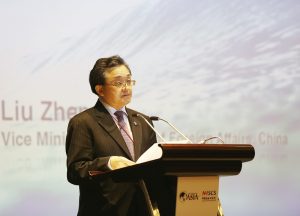On 7 November 2016, the second program of China-ASEAN Academy on Ocean Law and Governance is launched in Haikou, China. It is co-organized by the CSARC, National Institute for South China Sea Studies (NISCSS) and the International Ocean Institute (IOI)-Canada.
The ten-day program covers various subjects, such as the law of the sea, maritime delimitation, international shipping, regional security, climate change, environmental protection, living and non-living resources management and development, and comprehensive marine management. The courses are given in English by 17 prominent experts from China and abroad, including Vladimir Golitsyn (president of International Tribunal for the Law of the Sea) and Sorajak Kasemsuvan (former Vice Minister of Foreign Affairs of Thailand).
The participants are composed of over 30 scholars and officials from ocean-related agencies, universities and research institutions in China and ASEAN countries. There will be lectures, discussions, group course work and visits to Hainan Maritime Safety Administration and Hainan Academy of Ocean and Fisheries Sciences so that the participants can get an understanding of the development of ocean industries in Hainan.
As an important project under the auspices of China-ASEAN Maritime Cooperation Fund, this academy is designed as an institutionalized platform to promote maritime personnel training and exchanges among China and the ASEAN countries, and has been widely acclaimed since its launch. It will play a positive role in training maritime personnel and enhancing regional mutual trust. It will also have a far-reaching impact on the joint efforts of China and ASEAN countries to bolster maritime cooperation and build maritime silk road in the 21st century.
Participants and Speakers visited Hainan Academy of Ocean and Fisheries Sciences
On 13 November 2016, part of the participants and speakers of the 2nd program of China-ASEAN Academy on Ocean Law and Governance visited the Qionghai tropical marine fish aquaculture base affiliated with Hainan Academy of Ocean and Fisheries Sciences. They visited the breeding pools of aquatic creatures and grouper breeding system, and learned about the current conditions of the scientific research base, the development and protection of fishery resources, as well as the promotion of aquatic research results.
2nd program of China-ASEAN Academy on Ocean Law and Governance closed
On 16 November 2016, the closing ceremony of Second Program of China-ASEAN Academy on Ocean Law and Governance was successfully held at National Institute for South China Sea Studies.
Over 30 participants from China and ASEAN countries presented their coursework and answered lecturers’ questions. Dr. Wu Shicun, Chairman of the CSARC and president of the NISCSS, Judge Vladimir Golitsyn, president of International Tribunal for the Law of the Sea, and the lecturers of the program awarded the graduation certificates to all the participants.
In his closing remarks, Dr. Wu extended his gratitude to every lecturer and congratulations to the participants on their graduation. He also hoped that the participants could strengthen friendship and better apply the knowledge to future work so as to further promote regional cooperation.
In the speeches of the representatives from China and ASEAN, they believed that they benefited greatly from this program by enriching the knowledge of ocean law and governance, and deepening friendship and exchanges with participants from different countries as well.







